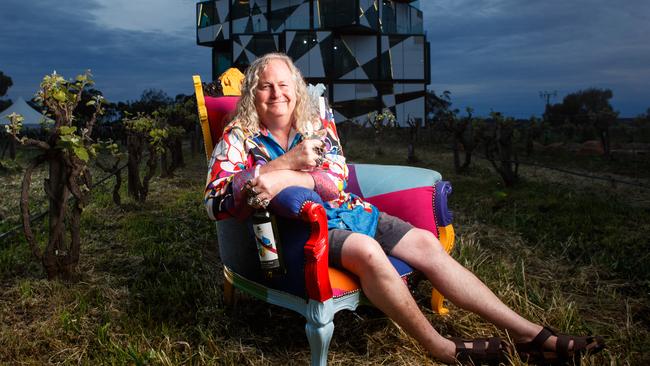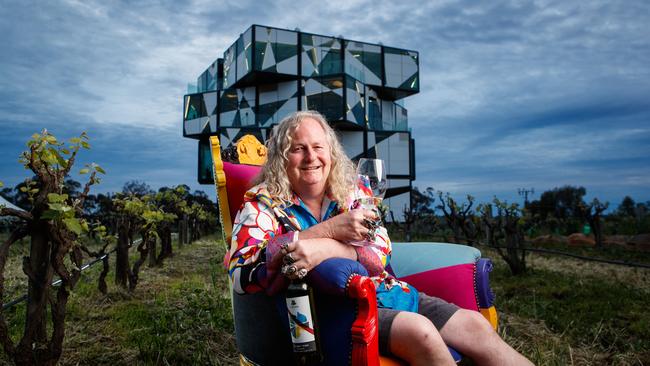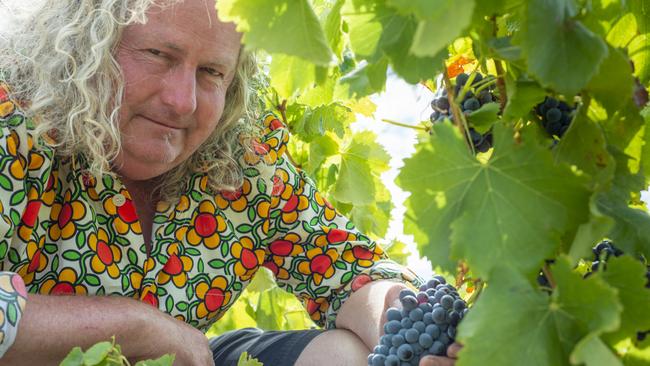d’Arenberg restructures debt, calls for renewed focus on US wine market
After a tough year, winemaker Chester Osborn says his McLaren Vale empire is solvent and is looking to US drinkers to soak up the huge oversupply of Australian wine.

Chester Osborn – the winemaker at d’Arenberg, which is famous for its absurdist-inspired cubist tower cellar door and restaurant in McLaren Vale – has called on the federal government to invest more in selling ‘‘brand Australia’’ in the US, saying the reopening of China is not the cure to Australia’s chronic wine glut.
The fourth generation winemaker at d’Arenberg, a colourful character in the nation’s wine industry, has warned that Australian wineries are sitting on at least a year’s worth of extra wine and that is putting downward pressure on prices and reducing the value of inventories.
This is an issue that has caused Osborn’s family-owned d’Arenberg wines some heartache, with the company’s latest accounts showing sharp writedowns of its wine inventory, fuelling a $5.7m loss for 2023 and seeing its bank, ANZ, waive some covenant conditions as it restructured a $26.55m loan.
“We did write down a whole heap of stock – that’s where most of the loss came from, it was an accounting treatment. We also had very low crops in 2019 and 2020,” Mr Osborn told The Australian.
“We have addressed the issues. Our balance sheet is very good, we have a lot of assets in our wine in the tanks, so we are solvent.”

According to the d’Arenberg accounts, ANZ removed the financial covenant relating to the winemaker’s earnings interest cover ratio in July 2023 and in September approved new finance facilities.
The lurch into the red of $5.7m in 2023 came after a slim profit of $70,000 in 2022 and a much better profit of $10.5m in 2021, as high tariffs in China robbed d’Arenberg of a key export customer.
“China was about 11 per cent of our volume and about 20 per cent of our dollar value, so obviously quite high, and probably around 30 per cent of our annual profits. Then with Russia and other places in war, it is all taking its toll on profitability in international markets, although the local market has held up pretty well,” Osborn says.
An investment of $9m in its vineyards, higher interest rates and the recent purchase of the nearby Settlers Spirits also weighed on the accounts.
Osborn says the d’Arenberg Cube venue, a five-storey building, is now paying for itself (it cost $16m to construct) but not attracting as many Chinese tourists as it once did.
“And international guests are also a bit less, but that isn’t a bad thing as it’s mostly the locals that buy most of the wine ... and direct sales have been very strong. Australia (sales) are doing pretty well for us.”
Osborn, whose family started making wine in McLaren Vale in 1912, says he hopes Chinese tariffs can be dismantled as trade tensions between Beijing and Canberra ease, but a slowing Chinese economy means it won’t take the volumes it once did, when Australia exported $1.3bn worth of wine.

“China will come back, we hope, but China is in a pretty bad way at the moment if you look at all the housing companies collapsing, and they have reduced their amount of drinking considerably and so it probably won’t come back as strong as it was.”
This means a challenge for winemakers amid a massive oversupply of wine, particularly reds.
“There is a surplus of red wine right now, about a year of extra stock than normal,” he says.
“Normally the ratio of stock (held by wineries) to sales is about 1.6 and right now it is about 2.6. Everyone is carrying an extra year’s worth of stock right now and that makes competition really tough.”
He says the recent lower harvest hasn’t rectified the oversupply, and many wineries might close down.
Osborn urges the Australian government to renew its focus on the US, which could be a huge export market but needs more investment.
“Australia only sells around 0.4 per cent of all the wine sold in America, which is almost insignificant, and it is the biggest market in the world,” he says.
“We were doing pretty well there and there is no reason why we can’t get that back.
“We need to do more marketing there, more effort, and where I think the money should be spent.
“There should be a whole marketing campaign of getting Australian winemakers to America and promoting in cities.
“That would make an enormous difference.”
He called on the federal government to revive the Export Market Development grant that could be used by winemakers in chasing new export customers.




